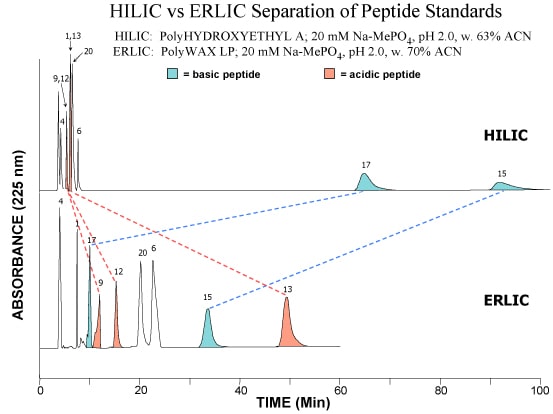Separation of Basic Peptide

Get In Touch
ERLIC is a new mode of chromatography that permits some separations to be done isocratically that normally would require a gradient. It also permits the selective isolation of phosphopeptides from a tryptic digest. In ERLIC, the column is of the same charge as the sample solutes. The mobile phase contains enough organic solvent so that hydrophilic interaction keeps the solutes on the column despite the electrostatic repulsion. The pH of the mobile phase is selected to insure that the solutes do have the same charge as the column. When the best-retained solutes in a mixture are highly charged, this combination can be used to selectively antagonize their retention.
· Cation-exchange columns (PolySULFOETHYL A™ or PolyCAT A™) are used for negatively charged solutes such as nucleotides and nucleic acids. Order PolySULFOETHYL A™ or PolyCAT A™ now.
· Anion-exchange columns (PolyWAX LP) are used for amino acids, peptides and proteins. Order PolyWAX LP™ now.
The example below shows the elution of a mixture of acidic, basic and neutral peptidesTOP: HILIC mode on a PolyHYDROXYETHYL A™ column. The basic peptides are much better retained than the neutral or basic peptides, since basic solutes are the most polar of all.
BOTTOM: ERLIC mode on a PolyWAX LP™ column. Selective repulsion of the basic peptides throws them into the same elution time frame as the other peptides.
Application Name : HILIC vs ERLIC Separation of Peptide Standards
Column Name : PolyHYDROXYETHYL A™ Columns
Analytes : Acidic peptide, Basic Peptide

ERLIC is a new mode of chromatography that permits some separations to be done isocratically that normally would require a gradient. It also permits the selective isolation of phosphopeptides from a tryptic digest. In ERLIC, the column is of the same charge as the sample solutes. The mobile phase contains enough organic solvent so that hydrophilic interaction keeps the solutes on the column despite the electrostatic repulsion. The pH of the mobile phase is selected to insure that the solutes do have the same charge as the column. When the best-retained solutes in a mixture are highly charged, this combination can be used to selectively antagonize their retention.
· Cation-exchange columns (PolySULFOETHYL A™ or PolyCAT A™) are used for negatively charged solutes such as nucleotides and nucleic acids. Order PolySULFOETHYL A™ or PolyCAT A™ now.
· Anion-exchange columns (PolyWAX LP) are used for amino acids, peptides and proteins. Order PolyWAX LP™ now.
The example below shows the elution of a mixture of acidic, basic and neutral peptidesTOP: HILIC mode on a PolyHYDROXYETHYL A™ column. The basic peptides are much better retained than the neutral or basic peptides, since basic solutes are the most polar of all.
BOTTOM: ERLIC mode on a PolyWAX LP™ column. Selective repulsion of the basic peptides throws them into the same elution time frame as the other peptides.
Application Name : ERLIC Separation of Peptide Standards
Column Name : PolyWAX LP™ Columns
Analytes : Acidic peptide, Basic Peptide
Get Your Quote or Call: 040-29881474
We focus on supporting laboratory workflows & optimizing lab-wide operations
